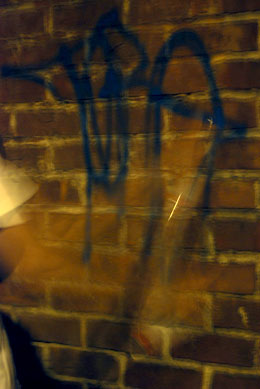The Mark of TORGO
Fernando is perhaps better known by his tag, TORGO. Fernando, in fact, isn’t even his real name. In exchange for disguising his identity, he’s agreed to grant me one lesson in the night school of graffiti, a pass into his realm of tags, bombs, throwies, beefing, buffing, and the like. In this one night, I hope to take in at least a partial education of the art form, its inspirations and intentions, its techniques and tactics.
Maybe it’s the joint transgressions, being together in the midst of broken laws, but Fernando and I have a sort of instant rapport even though this is only our second meeting. True, I’m here as an observer, not an accomplice, but to an arresting officer, the distinction would be moot.
I first met Fernando while polling friends as to their knowledge of the graffiti world. I had always found myself inexplicably drawn to the scrawlings I had seen on New York City buildings and, to a lesser extent, the back alleys of my South Dakota hometown. I wanted to gain some insight into this world that has struck me as both dangerously alluring and alluringly dangerous.
Now as we cruise, searching for an open stretch of wall, I look over and see him glowing in the light of a streetlamp, giddy with excitement. He strikes me as an unlikely graffiti artist. Perhaps it’s my relative naïveté when it comes to all things urban, but I generally expect bombers – as Fernando calls himself and other taggers – to be scrawny, shady characters, unable to leave their mark on the world in any way other than spray paint or permanent marker.
Fernando, though, has the body of someone who spends more time in a gym than in back alleys. His broad, expressive face tries to hide behind the thin goatee of a young man not quite able to sprout true facial hair. An honesty rests in his eyes. And though he seems proud of his street toughness, his quick smile and bright laughter betray his enthusiasm and almost childlike joy for life. At only 20 years old, he’s barely more than a child.
That’s not to say he’s without his element of intimidation, though.
When I first met him a week earlier in a fast food restaurant, he struck me as a cross between a hardened bike messenger and a gang member in the midst of rehabilitation. He wore an unzipped hooded sweatshirt and devoured his burrito with a voracity I hadn’t seen since eating with my high-school-football-playing brothers.
After an email inquiry, Fernando responded with a terse, “Yes, I do graffiti,” the statement that led to the meeting. Face to face, I was impressed and shocked by his candor, his insight, and his self-awareness.
“I do it for the thrill,” he told me. “It’s like every little sound, you don’t know what it is. You end up living in a heightened sensory state. It’s definitely a high and a thrill.”
He spoke of the evolution of graffiti, of its commercialization. He spoke of artists making the move to galleries and the way this flowed back to the streets. He spoke of women artists and how they fared in what he called “a male-dominated sport.”
He also spoke of graffiti as therapy. He called it a personal, meditative experience that gave him space and time to detach from the stresses of his everyday life.
This revelation, a lens through which I never considered the act of tagging, gave me pause with regard to my original goal for the meeting: to convince him to let me tag along with him on a night out. But, I sheepishly asked anyway, and was stunned when he agreed. In fact, he seemed downright delighted, as though no one had ever expressed an interest before.
We set the date, and I felt a sense of excitement well up within me.
That is, until I learned more details. We were going to Jersey.
Fernando told me that he was from Queens. So, I assumed that he tagged either there or in Manhattan. But he now lived in Union City, and wanted to hit up a few places in the surrounding area.
His reasoning actually caused me to feel the first inkling of connection to the stranger across from me, someone who I thought would be entirely alien. “New York takes too much work,” he said. “There are so many people who come here because it’s the Mecca of graffiti, and they’re tagging everywhere. So, in order to shine out above them, you have to do twice as much as they do.” He said that New Jersey was different. “Everything out there is so open and clean. New York is too cluttered.”
Flashes of the verdant mountains and pristine lakes of South Dakota floated before my eyes for a moment before I refocused on the grimy brick walls of the burrito joint. I knew what he meant.
So, I had hesitantly agreed and mentally started calculating my prospects of ever returning from a late-night ride on the PATH train. Much to my relief, though, Fernando called me the afternoon of the night we were to go out, and said he would have his car in the city. He would pick me up, and then we’d drive around. We’d cover more ground that way.
And so far tonight, we have. He’s now up to seven tags: four in spray paint and three in the fat marker. My education has begun.

